Chun-Liang Li
FocalLens: Instruction Tuning Enables Zero-Shot Conditional Image Representations
Apr 11, 2025Abstract:Visual understanding is inherently contextual -- what we focus on in an image depends on the task at hand. For instance, given an image of a person holding a bouquet of flowers, we may focus on either the person such as their clothing, or the type of flowers, depending on the context of interest. Yet, most existing image encoding paradigms represent an image as a fixed, generic feature vector, overlooking the potential needs of prioritizing varying visual information for different downstream use cases. In this work, we introduce FocalLens, a conditional visual encoding method that produces different representations for the same image based on the context of interest, expressed flexibly through natural language. We leverage vision instruction tuning data and contrastively finetune a pretrained vision encoder to take natural language instructions as additional inputs for producing conditional image representations. Extensive experiments validate that conditional image representation from FocalLens better pronounce the visual features of interest compared to generic features produced by standard vision encoders like CLIP. In addition, we show FocalLens further leads to performance improvements on a range of downstream tasks including image-image retrieval, image classification, and image-text retrieval, with an average gain of 5 and 10 points on the challenging SugarCrepe and MMVP-VLM benchmarks, respectively.
FastVLM: Efficient Vision Encoding for Vision Language Models
Dec 17, 2024



Abstract:Scaling the input image resolution is essential for enhancing the performance of Vision Language Models (VLMs), particularly in text-rich image understanding tasks. However, popular visual encoders such as ViTs become inefficient at high resolutions due to the large number of tokens and high encoding latency caused by stacked self-attention layers. At different operational resolutions, the vision encoder of a VLM can be optimized along two axes: reducing encoding latency and minimizing the number of visual tokens passed to the LLM, thereby lowering overall latency. Based on a comprehensive efficiency analysis of the interplay between image resolution, vision latency, token count, and LLM size, we introduce FastVLM, a model that achieves an optimized trade-off between latency, model size and accuracy. FastVLM incorporates FastViTHD, a novel hybrid vision encoder designed to output fewer tokens and significantly reduce encoding time for high-resolution images. Unlike previous methods, FastVLM achieves the optimal balance between visual token count and image resolution solely by scaling the input image, eliminating the need for additional token pruning and simplifying the model design. In the LLaVA-1.5 setup, FastVLM achieves 3.2$\times$ improvement in time-to-first-token (TTFT) while maintaining similar performance on VLM benchmarks compared to prior works. Compared to LLaVa-OneVision at the highest resolution (1152$\times$1152), FastVLM achieves comparable performance on key benchmarks like SeedBench and MMMU, using the same 0.5B LLM, but with 85$\times$ faster TTFT and a vision encoder that is 3.4$\times$ smaller.
MUSCLE: A Model Update Strategy for Compatible LLM Evolution
Jul 12, 2024



Abstract:Large Language Models (LLMs) are frequently updated due to data or architecture changes to improve their performance. When updating models, developers often focus on increasing overall performance metrics with less emphasis on being compatible with previous model versions. However, users often build a mental model of the functionality and capabilities of a particular machine learning model they are interacting with. They have to adapt their mental model with every update -- a draining task that can lead to user dissatisfaction. In practice, fine-tuned downstream task adapters rely on pretrained LLM base models. When these base models are updated, these user-facing downstream task models experience instance regression or negative flips -- previously correct instances are now predicted incorrectly. This happens even when the downstream task training procedures remain identical. Our work aims to provide seamless model updates to a user in two ways. First, we provide evaluation metrics for a notion of compatibility to prior model versions, specifically for generative tasks but also applicable for discriminative tasks. We observe regression and inconsistencies between different model versions on a diverse set of tasks and model updates. Second, we propose a training strategy to minimize the number of inconsistencies in model updates, involving training of a compatibility model that can enhance task fine-tuned language models. We reduce negative flips -- instances where a prior model version was correct, but a new model incorrect -- by up to 40% from Llama 1 to Llama 2.
Graph-Based Captioning: Enhancing Visual Descriptions by Interconnecting Region Captions
Jul 09, 2024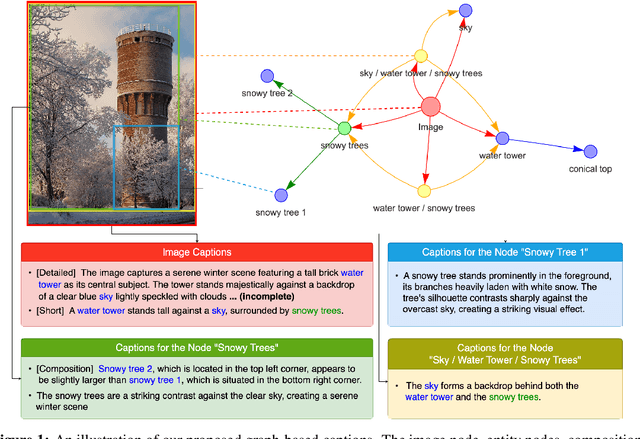

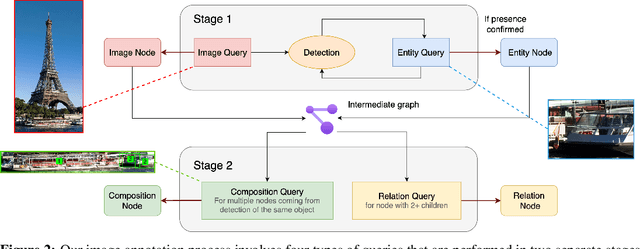

Abstract:Humans describe complex scenes with compositionality, using simple text descriptions enriched with links and relationships. While vision-language research has aimed to develop models with compositional understanding capabilities, this is not reflected yet in existing datasets which, for the most part, still use plain text to describe images. In this work, we propose a new annotation strategy, graph-based captioning (GBC) that describes an image using a labelled graph structure, with nodes of various types. The nodes in GBC are created using, in a first stage, object detection and dense captioning tools nested recursively to uncover and describe entity nodes, further linked together in a second stage by highlighting, using new types of nodes, compositions and relations among entities. Since all GBC nodes hold plain text descriptions, GBC retains the flexibility found in natural language, but can also encode hierarchical information in its edges. We demonstrate that GBC can be produced automatically, using off-the-shelf multimodal LLMs and open-vocabulary detection models, by building a new dataset, GBC10M, gathering GBC annotations for about 10M images of the CC12M dataset. We use GBC10M to showcase the wealth of node captions uncovered by GBC, as measured with CLIP training. We show that using GBC nodes' annotations -- notably those stored in composition and relation nodes -- results in significant performance boost on downstream models when compared to other dataset formats. To further explore the opportunities provided by GBC, we also propose a new attention mechanism that can leverage the entire GBC graph, with encouraging experimental results that show the extra benefits of incorporating the graph structure. Our datasets are released at \url{https://huggingface.co/graph-based-captions}.
Found in the Middle: Calibrating Positional Attention Bias Improves Long Context Utilization
Jun 23, 2024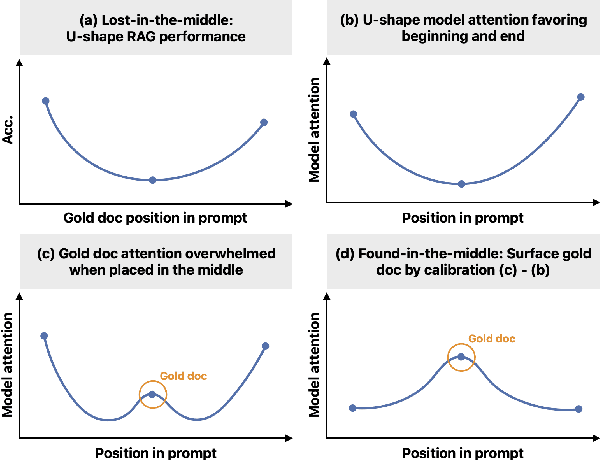

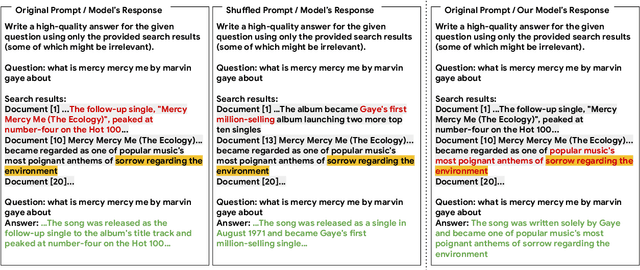

Abstract:Large language models (LLMs), even when specifically trained to process long input contexts, struggle to capture relevant information located in the middle of their input. This phenomenon has been known as the lost-in-the-middle problem. In this work, we make three contributions. First, we set out to understand the factors that cause this phenomenon. In doing so, we establish a connection between lost-in-the-middle to LLMs' intrinsic attention bias: LLMs exhibit a U-shaped attention bias where the tokens at the beginning and at the end of its input receive higher attention, regardless of their relevance. Second, we mitigate this positional bias through a calibration mechanism, found-in-the-middle, that allows the model to attend to contexts faithfully according to their relevance, even though when they are in the middle. Third, we show found-in-the-middle not only achieves better performance in locating relevant information within a long context, but also eventually leads to improved retrieval-augmented generation (RAG) performance across various tasks, outperforming existing methods by up to 15 percentage points. These findings open up future directions in understanding LLM attention bias and its potential consequences.
The Unmet Promise of Synthetic Training Images: Using Retrieved Real Images Performs Better
Jun 07, 2024Abstract:Generative text-to-image models enable us to synthesize unlimited amounts of images in a controllable manner, spurring many recent efforts to train vision models with synthetic data. However, every synthetic image ultimately originates from the upstream data used to train the generator. What additional value does the intermediate generator provide over directly training on relevant parts of the upstream data? Grounding this question in the setting of image classification, we compare finetuning on task-relevant, targeted synthetic data generated by Stable Diffusion -- a generative model trained on the LAION-2B dataset -- against finetuning on targeted real images retrieved directly from LAION-2B. We show that while synthetic data can benefit some downstream tasks, it is universally matched or outperformed by real data from our simple retrieval baseline. Our analysis suggests that this underperformance is partially due to generator artifacts and inaccurate task-relevant visual details in the synthetic images. Overall, we argue that retrieval is a critical baseline to consider when training with synthetic data -- a baseline that current methods do not yet surpass. We release code, data, and models at https://github.com/scottgeng00/unmet-promise.
Dataset Decomposition: Faster LLM Training with Variable Sequence Length Curriculum
May 21, 2024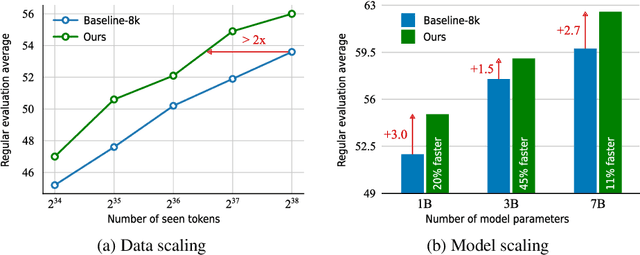



Abstract:Large language models (LLMs) are commonly trained on datasets consisting of fixed-length token sequences. These datasets are created by randomly concatenating documents of various lengths and then chunking them into sequences of a predetermined target length. However, this method of concatenation can lead to cross-document attention within a sequence, which is neither a desirable learning signal nor computationally efficient. Additionally, training on long sequences becomes computationally prohibitive due to the quadratic cost of attention. In this study, we introduce dataset decomposition, a novel variable sequence length training technique, to tackle these challenges. We decompose a dataset into a union of buckets, each containing sequences of the same size extracted from a unique document. During training, we use variable sequence length and batch size, sampling simultaneously from all buckets with a curriculum. In contrast to the concat-and-chunk baseline, which incurs a fixed attention cost at every step of training, our proposed method incurs a penalty proportional to the actual document lengths at each step, resulting in significant savings in training time. We train an 8k context-length 1B model at the same cost as a 2k context-length model trained with the baseline approach. Experiments on a web-scale corpus demonstrate that our approach significantly enhances performance on standard language evaluations and long-context benchmarks, reaching target accuracy 3x faster compared to the baseline. Our method not only enables efficient pretraining on long sequences but also scales effectively with dataset size. Lastly, we shed light on a critical yet less studied aspect of training large language models: the distribution and curriculum of sequence lengths, which results in a non-negligible difference in performance.
CodecLM: Aligning Language Models with Tailored Synthetic Data
Apr 08, 2024



Abstract:Instruction tuning has emerged as the key in aligning large language models (LLMs) with specific task instructions, thereby mitigating the discrepancy between the next-token prediction objective and users' actual goals. To reduce the labor and time cost to collect or annotate data by humans, researchers start to explore the use of LLMs to generate instruction-aligned synthetic data. Recent works focus on generating diverse instructions and applying LLM to increase instruction complexity, often neglecting downstream use cases. It remains unclear how to tailor high-quality data to elicit better instruction-following abilities in different target instruction distributions and LLMs. To this end, we introduce CodecLM, a general framework for adaptively generating high-quality synthetic data for LLM alignment with different downstream instruction distributions and LLMs. Drawing on the Encode-Decode principles, we use LLMs as codecs to guide the data generation process. We first encode seed instructions into metadata, which are concise keywords generated on-the-fly to capture the target instruction distribution, and then decode metadata to create tailored instructions. We also introduce Self-Rubrics and Contrastive Filtering during decoding to tailor data-efficient samples. Extensive experiments on four open-domain instruction following benchmarks validate the effectiveness of CodecLM over the current state-of-the-arts.
Chain-of-Table: Evolving Tables in the Reasoning Chain for Table Understanding
Jan 19, 2024Abstract:Table-based reasoning with large language models (LLMs) is a promising direction to tackle many table understanding tasks, such as table-based question answering and fact verification. Compared with generic reasoning, table-based reasoning requires the extraction of underlying semantics from both free-form questions and semi-structured tabular data. Chain-of-Thought and its similar approaches incorporate the reasoning chain in the form of textual context, but it is still an open question how to effectively leverage tabular data in the reasoning chain. We propose the Chain-of-Table framework, where tabular data is explicitly used in the reasoning chain as a proxy for intermediate thoughts. Specifically, we guide LLMs using in-context learning to iteratively generate operations and update the table to represent a tabular reasoning chain. LLMs can therefore dynamically plan the next operation based on the results of the previous ones. This continuous evolution of the table forms a chain, showing the reasoning process for a given tabular problem. The chain carries structured information of the intermediate results, enabling more accurate and reliable predictions. Chain-of-Table achieves new state-of-the-art performance on WikiTQ, FeTaQA, and TabFact benchmarks across multiple LLM choices.
Tool Documentation Enables Zero-Shot Tool-Usage with Large Language Models
Aug 01, 2023Abstract:Today, large language models (LLMs) are taught to use new tools by providing a few demonstrations of the tool's usage. Unfortunately, demonstrations are hard to acquire, and can result in undesirable biased usage if the wrong demonstration is chosen. Even in the rare scenario that demonstrations are readily available, there is no principled selection protocol to determine how many and which ones to provide. As tasks grow more complex, the selection search grows combinatorially and invariably becomes intractable. Our work provides an alternative to demonstrations: tool documentation. We advocate the use of tool documentation, descriptions for the individual tool usage, over demonstrations. We substantiate our claim through three main empirical findings on 6 tasks across both vision and language modalities. First, on existing benchmarks, zero-shot prompts with only tool documentation are sufficient for eliciting proper tool usage, achieving performance on par with few-shot prompts. Second, on a newly collected realistic tool-use dataset with hundreds of available tool APIs, we show that tool documentation is significantly more valuable than demonstrations, with zero-shot documentation significantly outperforming few-shot without documentation. Third, we highlight the benefits of tool documentations by tackling image generation and video tracking using just-released unseen state-of-the-art models as tools. Finally, we highlight the possibility of using tool documentation to automatically enable new applications: by using nothing more than the documentation of GroundingDino, Stable Diffusion, XMem, and SAM, LLMs can re-invent the functionalities of the just-released Grounded-SAM and Track Anything models.
 Add to Chrome
Add to Chrome Add to Firefox
Add to Firefox Add to Edge
Add to Edge